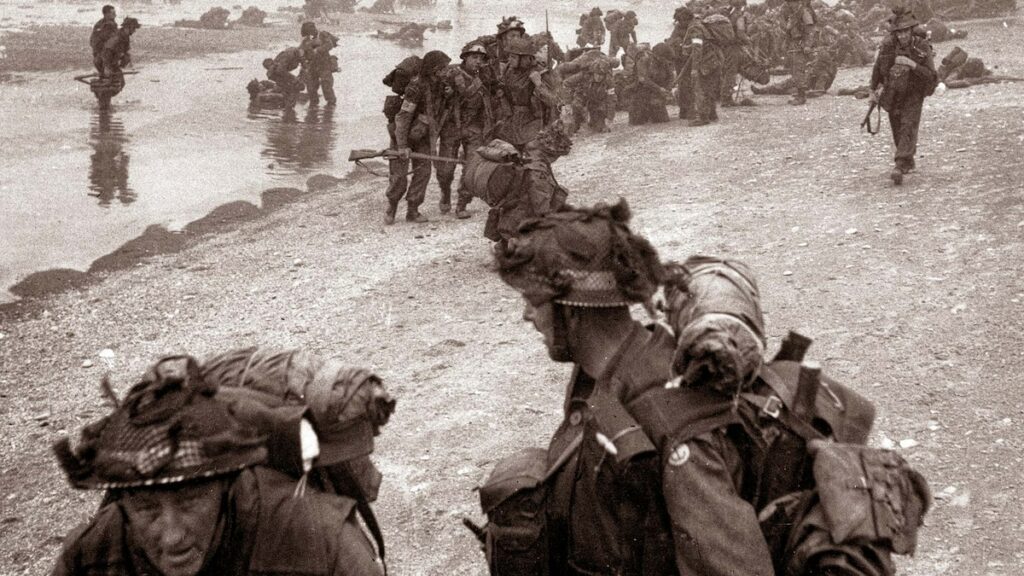On June 6, 1944, Allied forces began the formidable task of liberating Europe from the Nazis. The largest amphibious invasion in history, Operation Overlord was preceded by months of preparation in Britain, where hundreds of thousands of American troops were stationed in readiness.
(‘Top Secret’ maps reveal the massive Allied effort behind D-Day.)
Parade for a princess
Near Brighton, on England’s southern coast, 18-year-old Princess Elizabeth, the future queen, inspects an honor guard of the Second Battalion Grenadier Guards on May 17, 1944, during D-Day preparations. Incorporated into the British Army’s Guards Armoured Division, the Grenadiers landed in Normandy in mid-June, later taking part in the liberation of Brussels on September 3.
Evening Standard/Getty Images
Life goes on
U.S. military vehicles line a Southampton street and await transport to Normandy while Annie Bagg hangs out her wash, as usual, in 1944.
ACI
Teamwork
Supreme Allied Commander Dwight D. Eisenhower and Prime Minister Winston Churchill inspect U.S. paratroops in England in March 1944.
Fighting words
British troops of the Sixth Air landing Brigade inspect the message on their Horsa glider at an airfield in England. They would go on to cross the English Channel to Normandy, France, to carry out a drop of supplies and troops on the evening of June 6, 1944.
Piemags/Alamy/ACI
Rough crossing
At Gosport, England, a Sherman tank of the British 13th and 18th Royal Hussars boards a carrier on June 1, 1944. The tank would later land at Sword Beach. From there, the Hussars, as part of the 27th Armoured Brigade, would fight their way inland to participate in the Battle of Caen in early July.
(Memories of D-Day come alive on the beaches where it happened.)
Album/Universal Images Group/Universal History Archive
Mustering Allied Forces
In preparation for the attack, a fleet of landing craft passes the headquarters ship, H.M.S. Bulolo, on May 24, 1944, while King George VI reviews the procession from the ship. Landing craft were vital for the amphibious attack. The maneuvers took place in the “roads” between Southampton and the Isle of Wight, sheltered waters where, throughout history, great English fleets assembled before setting sail.
Leap of faith
Canadian troops of the Stormont, Dundas, and Glengarry Highlanders jump from their craft into the waters off Juno Beach in Normandy, carrying bicycles to travel inland quickly and quietly.
The thick of battle
British sappers (Royal Engineers tasked with repairing bridges and roads and laying and clearing bombs) arrive on Sword Beach on D-Day. Behind them, medics assist the wounded while, in the distance, commandos of the First Special Service Brigade disembark.
Album/Tallandier/Bridgeman
The greatest sacrifice
The bodies of Americans killed fighting for the liberation of France lie in a makeshift graveyard in Normandy. After the war, the bodies were recovered and transported back to the United States or to cemeteries in Europe. On D-Day alone—June 6, 1944—2,501 Americans were killed, making up more than half of the total Allied deaths that day. In the Battle of Normandy that followed, some 73,000 Allied servicemen died and 153,000 were wounded.
(Vintage photos honor the resting place of D-Day’s fallen heroes.)
Album/Granger, NYC
Guiding in the gliders
Gliders of the U.S. Ninth Air Force land in Normandy on the first day of the invasion. The Allies used gliders to land infantry, arms, and supplies. Gliders required high levels of skill by both their pilots and the planes that towed them into position. Here, the C-47 planes that had guided the gliders across the English Channel still circle overhead. A crashed glider sits away from the remaining aircrafts.
Album/Heritage Images/Keystone Archives
Street by street
American troops patrol Carentan, Normandy, in August 1944. After a ferocious house-to-house battle, German forces surrendered the town of Carentan to the U.S. 101st Airborne Division on June 14, 1944. Its capture provided the Allies with a staging post to attack the vital port of Cherbourg.
Liberté, égalité, fraternité
Acclaimed by crowds after four years of Nazi occupation, French military vehicles parade in front of the Arc de Triomphe, in Paris, on August 26, 1944. Two days earlier, U.S.-supplied Sherman tanks of the French Ninth Company (known as La Nueve and mainly crewed by Spaniards) were the first to reach central Paris. The U.S. Fourth Infantry Division followed the next day. Paris was free but hungry. The Allies would devote much time to restoring supply lines to the French capital.
(In honor of D-Day, here’s how to visit the Normandy coast.)
>>> Read full article>>>
Copyright for syndicated content belongs to the linked Source : National Geographic – https://www.nationalgeographic.com/premium/article/d-day-anniversary-80-years
